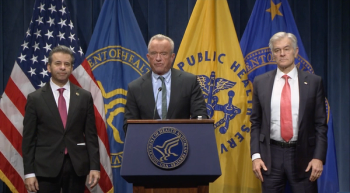
- August 2017
- Volume 23
- Issue SP10
Medical World News®, August 2017
An update on the latest developments in the world of oncology care: product approvals, clinical developments, health policy changes, and more.
CMS Proposes Payment Rate Change for 340B Program
Laura Joszt
Reform may be coming to the controversial 340B Drug Discount Program, a federal program that requires drug companies to provide discounts to hospitals, clinics, and covered entities that include freestanding cancer centers.
In January 2017, the Health Resources and Services Administration (HRSA) within HHS finalized a rule that would set the 340B ceiling price and allow HRSA to fine manufacturers up to $5000 for each incident of knowing and intentionally overcharging 340B hospitals for drugs purchased through the program. However, the rule was pulled back by the Trump administration.
Now, the new administration has proposed its own change to the payment rate for certain Medicare Part B drugs purchased by hospitals through the 340B program. According to CMS Administrator Seema Verma, “The proposed rule takes a critical step toward fulfilling President Trump’s promise to lower the cost of drugs, particularly for Medicare beneficiaries.”1
The proposal gained immediate support from the Community Oncology Alliance (COA), which has previously called out abuses taking place in the 340B program. The program was created with good intentions, COA has argued, but it has morphed into an opportunity for hospitals to make tremendous profits by buying deeply discounted drugs and selling them to patients at full price.
“Community oncology practices across the country will tell you that hospitals have been strong-arming them to sell or close because of the tremendous profits they make from the 340B program and higher billing rates,” said Jeff Vacirca, MD, president of COA and CEO of NY Cancer and Blood Specialists on Long Island, NY, in a statement.2
The proposal would implement a new payment methodology for Medicare Part B reimbursement for 340B drugs, which would cut reimbursement by close to 30%: entities would be allowed to purchase discounted 340B drugs at the average sales price (ASP) minus 22.5% rather than the ASP plus 6%. The Medicare Payment Advisory Commission estimated that this was the average minimum discount that eligible hospitals could receive for drugs purchased through the 340B program.
The comment period for the rule will be open through September 11, 2017, and the proposed rule will take effect January 1, 2018.
“We applaud HHS Secretary Price and CMS Administrator Verma for taking this bold step in curtailing hospital abuse of the 340B program and further addressing site payment parity,” said Ted Okon, MBA, executive director of COA. “These proposals represent a good first step, but the administration and Congress must take additional steps to address the alarming consolidation of cancer care that is fueling drug prices and driving up costs for seniors and taxpayers.”
REFERENCES
1. Joszt L. CMS proposes 2018 policy and rate changes for hospital outpatient, ambulatory surgical center payment systems. The American Journal of Managed Care® website. ajmc.com/newsroom/cms-proposes-payment-rate-change-for-340b-program. Published July 17, 2017. Accessed July 17, 2017.
2. CMS proposal a huge step in the right direction to curbing 340B hospital abuses, stopping cancer system consolidation, and reducing costs for seniors. Community Oncology Alliance website. communityoncology.org/blog/2017/07/17/july-17-cms-proposal-a-huge-step-in-the-right-direction-to-curbing-340b-hospital-abuses-stopping-cancer-system-consolidation-and-reducing-costs-for-seniors/. July 17, 2017.
Rural America’s High Cancer Mortality Rates Point to Growing Disparities
Christina Mattina
A recent analysis of cancer incidence and mortality rates across America found that while those in rural counties are less likely to get cancer, cancer-related mortality rates are higher than in more populous areas and this disparity is increasing over time.
The surveillance study, conducted by CDC researchers, was published in the Morbidity and Mortality Weekly Report.1 It used data from several national registries to calculate average annual age-adjusted incidence and death rates in 4 types of counties:
- Nonmetropolitan rural
- Nonmetropolitan urban
- Metropolitan with population <1 million
- Metropolitan with population ≥1 million
It also compared the trends in these rates in recent years among counties classified as nonmetropolitan or metropolitan. From 2004 to 2013, the incidence rates of cancers at all sites was lower in rural counties than in the other county types, but rural residents had higher rates of developing lung, colorectal, and cervical cancers. Overall incidence rates in nonmetropolitan counties decreased by about 0.8% per year during this period, while they decreased in metropolitan counties by 1% annually.
Cancer death rates were higher in nonmetropolitan rural counties than the others during 2011 to 2015. Although cancer mortality decreased nationwide from 2006 to 2015, death rates showed a steeper decline in metropolitan counties than in nonmetropolitan counties (1.6% decrease vs 1.0% decrease per year, respectively). To explain the findings, the researchers referenced prior studies showing that rural residents are more likely to have risk factors for cancer, such as cigarette smoking or obesity, and may have more difficulty accessing screening due to higher uninsurance rates.
“While geography alone can’t predict your risk of cancer, it can impact prevention, diagnosis, and treatment opportunities—and that’s a significant public health problem in the United States,” said Anne Schuchat, MD, acting director of the CDC, in a press release.2 “Many cancer cases and deaths are preventable, and with targeted public health efforts and interventions, we can close the growing cancer gap between rural and urban Americans.”
According to the study results, these interventions will need to use “evidence-based strategies to improve health-related behaviors, use of vaccinations that prevent infections with cancer-causing viruses, and use of cancer screening tests” among rural residents in particular.
A blog post by Robert T. Croyle, PhD, of the National Cancer Institute (NCI), explored the potential next steps toward reducing cancer disparities in light of both the CDC study and a recent NCI commentary that discussed the issue.3 He called for stronger outreach to rural community organizations and for a better understanding of the racial demographics in rural areas. Croyle also noted that the NCI will host a meeting in May 2018 to collaborate with researchers on potential solutions to reduce rural disparities.
“In the meantime, NCI will continue to work with the cancer community and others to refine and reinvigorate our cancer control efforts in rural areas across the country,” he concluded.
REFERENCES
1. Jane Henley S, Anderson RN, Thomas CC, Massetti GM, Peaker B, Richardson LC, Invasive cancer incidence, 2004-2013, and deaths, 2006-2015, in nonmetropolitan and metropolitan counties—United States. CDC website. cdc.gov/mmwr/volumes/66/ss/ss6614a1.htm?s_cid=ss6614a1_w#contribAff. Accessed July 10, 2017.
2. New CDC report shows deaths from cancer higher in rural America [press release]. Atlanta, GA: CDC; July 6, 2017. cdc.gov/media/releases/2017/p0706-rural-cancer-deaths.html. Accessed July 10, 2017.
3. Croyle RT. Improving cancer control in rural communities: next steps. National Cancer Institute website. cancer.gov/news-events/cancer-currents-blog/2017/rural-cancer-disparities-next-steps?cid=eb_govdel. Published July 7, 2017. Accessed July 10, 2017.
FDA Considers Label Changes for Some Immunotherapies Due to Potential Vision Loss
Alison Rodriguez
The FDA is considering adding the risk of ocular inflammatory conditions to labels for 3 immune checkpoint inhibitors due to sight-threatening complications. The drugs that could have label changes include Bristol- Myers Squibb’s Yervoy (ipilimumab) and Opdivo (nivolumab) and Merck’s Keytruda (pembrolizumab). The 3 labels currently list uveitis, a type of eye inflammation, as a potential immune-mediated adverse reaction, but the FDA’s postmarketing reviews have found further complications including retinal detachment and vision loss.1
Ocular inflammation resulting in vision loss was also observed in a study that treated metastatic melanoma with ipilimumab. The study involved a male patient that was diagnosed with melanoma that progressed during treatment. Eventually, he participated in a clinical trial for ipilimumab and received 3mg/ kg every 3 weeks for 3 doses.2
Following treatment, he experienced adverse effects (AEs), including a rash and diarrhea, which were treated with supportive therapy, and headaches that were resolved with steroids. However, 4 months after the initial treatment, the participant experienced acute vision loss in his left eye, followed by vision loss in his right eye after 5 months.
“High-dose steroid therapy stabilized the right eye vision, but the left eye vision never improved after initial presentation, again supporting a probable vascular cause for the left eye visual loss,” the study noted. “This may or may not have been secondary to an inflammatory/immune-mediated process (ie, local thrombosis related to inflammation/vasculitis).”
Furthermore, the steroids taken by the patient to treat the AEs from the ipilimumab treatment caused further complications. The FDA is considering labeling changes to emphasize the risks of these complications.
“Regulatory discussions are ongoing regarding PD-1 pathway—blocking antibodies in attempts to improve the consistency and effectiveness of the information regarding immune-mediated AEs provided in the labels,” explained Tralisa Colby, an FDA public affairs specialist, in a statement to Regulatory Focus. “Those labeling changes may include additional characterization of ocular inflammatory conditions; however, the current term, uveitis, should convey the severity and potential ocular complications to oncology physicians.”3
REFERENCES
1. Potential signals of serious risks/new safety information identified by the FDA Adverse Event Reporting System (FAERS): January-March 2017. FDA website. fda.gov/Drugs/GuidanceComplianceRegulatoryInformation/Surveillance/ AdverseDrugEffects/ucm565425.htm. Updated June 30, 2017. Accessed July 17, 2017.
2. Wilson MA, Guld K, Galetta S, et al. Acute visual loss after ipilimumab treatment for metastatic melanoma. J Immunother Cancer. 2016;4:66. eCollection 2016. doi: 10.1186/s40425-016-0170-9.
3. Brennan Z. FDA considers label changes for Keytruda, Opdivo and Yervoy. Regulators Affairs Professionals Society website. raps.org/Regulatory-Focus/News/2017/07/12/28070/FDA-Considers-Label-Changes-for-Keytruda-Opdivo-and-Yervoy/. Published July 12, 2017. Accessed July 17, 2017.
FDA Advisory Committee Confirms Support for Biosimilars to Trastuzumab, Bevacizumab
Surabhi Dangi-Garimella, PhD
A 17-0 vote in favor of the Amgen/Allergan bevacizumab biosimilar candidate, ABP 215, and a 16-0 vote in favor of Mylan’s trastuzumab biosimilar candidate, MYL-1401O were the final tiles following voting by the FDA’s Oncologic Drugs Advisory Committee (ODAC) on the 2 pioneer biosimilar candidates for cancer treatment.
Both of the reference drugs, trastuzumab (Herceptin) and bevacizumab (Avastin), are manufactured by Roche and are blockbusters in their own right: together they brought in $5.6 billion in sales in 2016.1 Bevacizumab is indicated for the treatment of patients with unresectable, locally advanced, recurrent or metastatic nonsquamous non—small cell lung cancer (NSCLC), metastatic carcinoma of the colon or rectum, metastatic renal cell carcinoma, and other region-specific indications. Trastuzumab is indicated for the treatment of HER2-positive breast cancer following surgery, for metastatic disease, and for gastric cancer.
In a briefing document released prior to the meeting, the ODAC committee members stated that the “totality of evidence” submitted by Amgen showed that the lung cancer data can be extrapolated to other indications of bevacizumab. This was following evaluation of phase 3 data from the company, which showed the biosimilar candidate had similar safety and immunogenicity as the reference product in patients with NSCLC. However, a few ODAC members did raise concerns over extrapolating data from studies conducted in a single disease to multiple indications.
In a release prior to the beginning of the day’s proceedings, David Nicholson, chief R&D officer at Allergan, said, “ABP 215 is the first product of our collaboration with Amgen to reach this important milestone. If approved, ABP 215 has the potential to provide another high-quality treatment option for cancer patients and pave the way for additional high-quality oncology biosimilars from Allergan and Amgen.”2
ABP 215 has a Biosimilar User Fee Act date of September 14, while the date for MYL-1401O is September 3.
REFERENCES
1. Sagonowsky E. Roche’s hold on Avastin, Herceptin sales loosens as FDA panel backs Amgen and Mylan biosims. FiercePharma website. fiercepharma.com/pharma/amgen-mylan-biosims-to-roche-blockbusters-under-review-at-fda-panel. Published July 13, 2017. Accessed July 13, 2017.
2. Amgen and Allergan to discuss data supporting biologics license application for ABP 215, a biosimilar candidate to Avastin (bevacizumab) [press release]. Thousand Oaks, CA: Amgen; July 13, 2017. amgen.com/media/news-releases/2017/07/amgen-and-allergan-to-discuss-data-supporting-biologics-license-application-for-abp-215-a-biosimilar-candidate-to-avastin-bevacizumab/. Accessed July 13, 2017.
Is Complete Lymph Node Dissection Essential in Melanoma?
Surabhi Dangi-Garimella, PhD
Sentinel lymph node biopsy in patients with diagnosed melanoma helps establish the spread of the disease beyond the cancer site. However, according to findings from a 63-center international study, complete lymph node excision may not be essential for to improve melanoma outcomes.
Relatively rare, but significantly deadly, melanoma makes up less than 1% of skin cancers although it is responsible for a majority of skin cancer-related deaths; almost 10,000 deaths are projected for 2017.1 Sentinel lymph nodes are routinely surgically removed because they are the closest draining lymph nodes where melanoma is known to spread. Standard treatment involves removing all nearby lymph nodes, which can sometimes trigger complications.
“They can have repeat hospitalizations for infections in their extremities. They can have life-limiting, painful swelling where they can’t do the activities they like to do or wear their usual clothing. It’s a significant, real problem for patients who are affected,” explained2 study author Tawnya L. Bowles, MD.
For the present study, the Multicenter Selective Lymphadenectomy Trial II, published in the New England Journal of Medicine, more than 3500 patients across 63 centers around the world, including the Intermountain Medical Center and the Huntsman Cancer Institute in Salt Lake City, were recruited; 1939 patients had an abnormal lymph-node biopsy.3 Patients were randomly assigned to standard of care and had complete lymph-node dissection (dissection group) or nodal observation with ultrasonography (observation group). Ultrasounds were scheduled at every 4 months for the first 2 years, followed by every 6 months over the next 3 years. The primary trial endpoints included disease-free survival (DFS) and cumulative rate of nonsentinel-node metastases.
The study found that complete lymph node dissection was not associated with increased melanoma-specific survival, based on data from an intent-to-treat analysis or 1755 in the per-protocol analysis, the authors write. The mean 3-year rate of melanoma-specific survival was similar between the dissection group (86%±1.3%) and the observation group (86%±1.2%; P = .42), as observed following a median follow-up of 43 months. DFS, however, was higher in the dissection group (68%±1.7%) than in the observation group (63%±1.7%; P = .05) at 3 years.
Nonsentinelnode metastases were a strong independent predictor of recurrence in 11.5% of patients (HR, 1.78; P = .005). “If the sentinel node biopsy hadn’t been done, the tumor present in the lymph node would have grown and progressed,” said Bowles. “Checking that lymph node is really important, but many patients can be spared taking out the others.”
She also pointed out the importance of immune therapy in these patients, especially in the context of distant metastases, which is the most common reason for mortality among patients with melanoma. The question is, would outcomes be different in patients treated with immunotherapies, such as nivolumab or pembrolizumab, who do not have their lymph nodes removed?
REFERENCES
1. Key statistics for melanoma skin cancer. American Cancer Society website. cancer.org/cancer/melanoma-skin-cancer/about/key-statistics.html. Revised January 6, 2017. Accessed July 18, 2017.
2. Lymph node removal isn’t necessary for all melanoma patients, new study finds. ScienceDaily website. sciencedaily.com/releases/2017/07/170717100441.htm. Published July 17, 2017. Accessed July 18, 2017.
3. Faries MB, Thompson JF, Cochran AJ, et al. Completion dissection or observation for sentinel-node metastasis in melanoma. N Engl J Med. 2017;376(23):2211-2222. doi: 10.1056/NEJMoa1613210.
Neratinib Approved as Extended Adjuvant Breast Cancer Treatment, Carries Diarrhea Risk
Christina Mattina
The FDA has approved neratinib (Nerlynx) for the extended adjuvant treatment of some forms of breast cancer, but recommends taking precautions against the common side effect of diarrhea.
As an extended adjuvant treatment, neratinib is intended to be taken after initial treatment to reduce odds of the cancer returning. Specifically, it is indicated for patients whose early stage, HER2-positive breast cancer has been treated with a trastuzumab-based therapy regimen, according to an FDA press release.1
A randomized trial of nearly 3000 patients found that 94.2% of those who received neratinib did not experience cancer recurrence or death after 2 years compared with 91.9% of patients taking a placebo. This ability to keep cancer recurrences at bay is especially important for the 15% of patients with breast cancer whose tumors are HER2-positive, FDA officials explained.
“HER2-positive breast cancers are aggressive tumors and can spread to other parts of the body, making adjuvant therapy an important part of the treatment plan,” said Richard Pazdur, MD, director of the FDA’s Oncology Center of Excellence and acting director of the Office of Hematology and Oncology Products in the FDA’s Center for Drug Evaluation and Research, in the press statement. “Now, these patients have an option after initial treatment that may help keep the cancer from coming back.”
The approval was accompanied by warnings of the drug’s potential side effects, most notably diarrhea. More than just an unpleasant symptom, this diarrhea can be severe and cause dehydration. As such, the FDA stated that patients should take loperamide, an antidiarrheal medication sold over the counter as Imodium, for the first 56 days of treatment and as necessary thereafter. Rates of diarrhea experienced in study populations were not specified in the approval announcement, but a prior report by Advera Health found that 90% of neratinib patients in 11 clinical trials experienced diarrhea and 19% experienced serious cases, according to a September 2016 report in FiercePharma.2
At the time, Puma Biotechnology, which manufactures neratinib, sought to downplay these findings. Alan Auerbach, chief executive, pointed out to FiercePharma that rates of diarrhea appeared high because few of the studies used loperamide to prevent it. “When you use the Imodium, the rates come down dramatically and it completely changes the safety and tolerability profile of the drug,” he said.
Puma’s press statement in response to the FDA’s approval of neratinib mentions diarrhea as a potentially severe side effect and provides recommendations to mitigate the risk, including taking loperamide.3 However, the statement mainly focuses on the approval’s implications for women with breast cancer and the improved peace of mind that neratinib could provide after treatment.
“Despite advances in the treatment of early-stage HER2-positive breast cancer, there remains a need for further therapeutic improvements in order to attempt to further reduce the risk of disease recurrence,” said Auerbach in the press release. “We are pleased to be able to bring this new medicine to patients with breast cancer.”
Neratinib, which is a tyrosine kinase inhibitor that blocks enzymes that promote cell growth, is currently being reviewed by the European Medicines Agency for sale in Europe. Neither Puma nor the FDA specified a date for when neratinib would enter the US market.
REFERENCES
1. FDA approves new treatment to reduce the risk of breast cancer returning [press release]. Silver Spring, MD: FDA; July 17, 2017. fda.gov/NewsEvents/Newsroom/PressAnnouncements/ucm567309.htm.
2. Sagonowsky E. Cancer hopeful neratinib plagued by diarrhea, analysis shows, but Puma cites a solution. FiercePharma website. fiercepharma.com/pharma/puma-s-neratinib-comes-safety-risks-advera-report-says. Published September 27, 2016. Accessed July 17, 2017.
3. US Food and Drug Administration approves Puma’s NERLYNX (neratinib) for extended adjuvant treatment of HER2-positive early stage breast cancer [press release]. Los Angeles, CA: Puma Biotechnology; July 17, 2017. pumabiotechnology.com/pr20170717.html. Accessed July 17, 2017.
Articles in this issue
about 8 years ago
Targeted Therapies: One Practice's Storyabout 8 years ago
Letter to the Editorsabout 8 years ago
The Newest Members of CancerLinQ's Community—FDA and NCIabout 8 years ago
Q&A With Syapse CEO Ken Tarkoffabout 8 years ago
Genetic Counselors Save Costs Across the Genetic Testing Spectrumabout 8 years ago
Patient Engagement Is Mandatory at Our Tableabout 8 years ago
AJMCtv® Interviews, August 2017Newsletter
Stay ahead of policy, cost, and value—subscribe to AJMC for expert insights at the intersection of clinical care and health economics.
















































